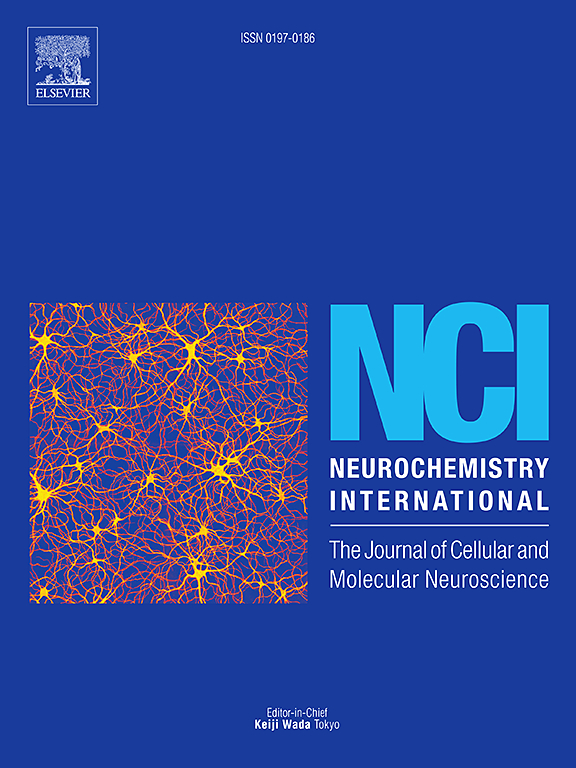桑叶提取物对抗促聚集tau介导的炎症和线粒体功能障碍的潜力
IF 4
3区 医学
Q2 BIOCHEMISTRY & MOLECULAR BIOLOGY
引用次数: 0
摘要
在阿尔茨海默病(AD)中,Tau聚集物触发小胶质细胞激活,释放炎症因子,导致线粒体功能障碍、氧化应激和神经元损伤。桑树(Morus alba L.)叶提取物富含强效抗氧化剂,具有治疗神经炎症、线粒体功能障碍和氧化应激相关疾病的潜力。本研究检测了桑叶提取物对表达ΔK280 Tau重复结构域(TauRD)的SH-SY5Y细胞中促聚集性Tau介导的炎症和线粒体功能障碍的神经保护作用。大肠杆菌制备的含有his标记的ΔK280 TauRD原纤维激活了BV-2小胶质细胞,其形态学改变,一氧化氮生成增加,离子钙结合接头分子1 (IBA1)和主要组织相容性复合体2 (MHCII)表达升高。桑叶提取物可抑制ΔK280 TauRD原纤维刺激的BV-2细胞中NO、IL-1β、IL-6和TNF-α等促炎介质的产生,以及NLR家族pyrin domain-containing 3 (NLRP3)和caspase-1 (CASP1)的表达。应用从ΔK280 TauRD原纤维激活的BV-2细胞中收集的条件培养基诱导ΔK280 TauRD- dsred表达的SH-SY5Y细胞发生细胞炎症。桑叶提取物通过抑制乳酸脱氢酶(LDH)释放、caspase-3活性、NLR家族pyrin结构域1 (NLRP1)、CASP1、IL-1β、IL-6、TNF-α和活性氧以及促进神经突生长来保护这些细胞。此外,桑叶提取物增加了SH-SY5Y细胞的线粒体膜电位,降低了线粒体超氧化物水平,增加了超氧化物歧化酶2 (SOD2)、NAD(P)H醌脱氢酶1 (NQO1)、谷氨酸-半胱氨酸连接酶催化亚基(GCLC)和核因子红系2相关因子2 (NRF2)水平。综上所述,桑叶提取物通过发挥抗炎和抗氧化活性,改善人Tau细胞模型中病理性Tau介导的线粒体功能障碍,具有神经保护作用。本研究的结果支持了桑叶提取物是一种潜在的疾病改善治疗剂的观点。本文章由计算机程序翻译,如有差异,请以英文原文为准。
The potential of mulberry (Morus alba L.) leaf extract against pro-aggregant tau-mediated inflammation and mitochondrial dysfunction
In Alzheimer's disease (AD), Tau aggregates trigger microglial activation to release inflammatory factors and cause mitochondrial dysfunction, oxidative stress, and neuronal damage. With abundant potent antioxidants, mulberry (Morus alba L.) leaf extract has the potential to treat diseases associated with neuroinflammation, mitochondrial dysfunction, and oxidative stress. This study examined the neuroprotective effects of a mulberry leaf extract against pro-aggregant Tau-mediated inflammation and mitochondrial dysfunction in SH-SY5Y cells expressing the ΔK280 Tau repeat domain (TauRD). His-tagged ΔK280 TauRD fibrils prepared from E. coli activated BV-2 microglia, as revealed by their altered morphology, increased nitric oxide production, and elevated ionized calcium binding adaptor molecule 1 (IBA1) and major histocompatibility complex 2 (MHCII) expression. The mulberry leaf extract suppressed the production of pro-inflammatory mediators, including NO, IL-1β, IL-6, and TNF-α, and the expression of NLR family pyrin domain-containing 3 (NLRP3) and caspase-1 (CASP1) in ΔK280 TauRD fibril-stimulated BV-2 cells. Application of conditioned media collected from ΔK280 TauRD fibril-activated BV-2 cells induced cellular inflammation in ΔK280 TauRD-DsRed-expressing SH-SY5Y cells. The mulberry leaf extract protected these cells by suppressing lactate dehydrogenase (LDH) release, caspase-3 activity, NLR family pyrin domain-containing 1 (NLRP1), CASP1, IL-1β, IL-6, TNF-α, and reactive oxygen species as well as by enhancing neurite outgrowth. In addition, mulberry leaf extract increased mitochondrial membrane potential, lowered mitochondrial superoxide levels, and increased superoxide dismutase 2 (SOD2), NAD(P)H quinone dehydrogenase 1 (NQO1), glutamate-cysteine ligase catalytic subunit (GCLC), and nuclear factor erythroid 2-related factor 2 (NRF2) levels in SH-SY5Y cells. In conclusion, mulberry leaf extract displayed neuroprotective effects by exerting anti-inflammatory and antioxidative activities to ameliorate pathological Tau-mediated mitochondrial dysfunction in a human Tau cell model. The results of this study support the notion that the mulberry leaf extract is a potential disease-modifying therapeutic agent for AD.
求助全文
通过发布文献求助,成功后即可免费获取论文全文。
去求助
来源期刊

Neurochemistry international
医学-神经科学
CiteScore
8.40
自引率
2.40%
发文量
128
审稿时长
37 days
期刊介绍:
Neurochemistry International is devoted to the rapid publication of outstanding original articles and timely reviews in neurochemistry. Manuscripts on a broad range of topics will be considered, including molecular and cellular neurochemistry, neuropharmacology and genetic aspects of CNS function, neuroimmunology, metabolism as well as the neurochemistry of neurological and psychiatric disorders of the CNS.
 求助内容:
求助内容: 应助结果提醒方式:
应助结果提醒方式:


